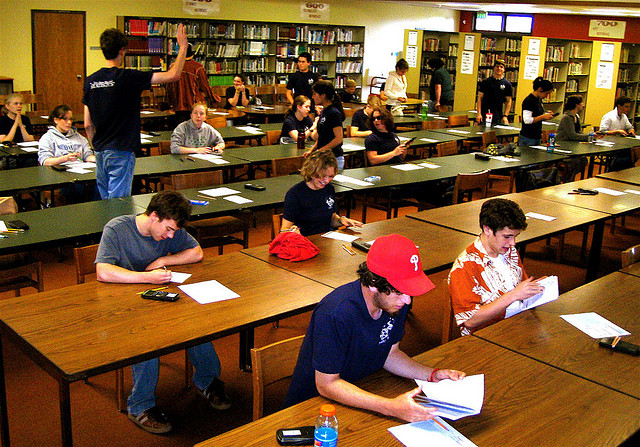
As senioritis infects graduating classes across the U.S., one group of students is denied the thrill of the “senior slide”: those enrolled in Advanced Placement courses. These students look forward to a grueling gauntlet of 3-hour exams on topics ranging from Computer Science to Studio Art to Chinese Language and Culture. The tests are rigorous, cumulative assessments of each student’s mastery of an entire year’s worth of class content, and they have extremely high stakes. College Board, the organization that creates and scores the exams (as well as the SAT), claims high AP scores help students “stand out in the admissions process.” While these tests only seem to target elite, high achieving students, they also impact educational processes school-wide.
AP classes are a source of inequality in educational attainment. Minority and low-income students are more likely to attend schools offering fewer AP courses. Even when courses are available, these students are also more likely to be underrepresented in them relative to their more affluent and white peers.
- Grace Kao and Jennifer S. Thompson. 2003. “Racial and Ethnic Stratification in Educational Achievement and Attainment.” Annual Review of Sociology 29:417-442.
- Daniel G. Solorzano and Armida Ornelas. 2004. “A Critical Race analysis of Latina/o and African American Advanced Placement Enrollment in Public High Schools.” The High School Journal, 87(3): 15-26.
Policies aiming to increase AP courses at underprivileged schools may be one way to narrow the gap, since parent/student demand and school officials’ response in more affluent districts are likely driving the difference. The proportion of upper-middle class students at a school is an excellent predictor of both the number of AP courses offered and the number of students who enroll.
- Joshua Klugman. 2013. The Advanced Placement Arms Race and the Reproduction of Educational Inequality. Teachers College Record, 115(5):1-34.
- Thurston Domina and Joshua Saldana. 2012. Does Raising the Bar Level the Playing Field? Mathematics curricular intensification and inequality in American high schools, 1982–2004. American Educational Research Journal, 49(4): 685-708.
AP tests weren’t always used in college admissions. They were originally designed to allow high-achieving students to place out of introductory courses and into more advanced college work. Only in recent years have they become an important indicator for college admissions boards.
- Saul Geiser and Veronica Santelices. 2004. The Role of Advanced Placement and Honors Courses in College Admissions. Expanding opportunity in higher education: Leveraging promise, 75-113.
AP testing culture affects all students, no matter where they’re tracked. In most cases, tests change curricula by narrowing content to tested subjects, fragmenting content area knowledge into test-related pieces, and increasing teacher-centered instruction. However, certain types of high-stakes tests can encourage curricular content expansion, integration of knowledge, and cooperative learning.
- Wayne Au. 2007. “High-stakes Testing and Curricular Control: A qualitative metasynthesis.” Educational Researcher (36)5:258-267.

Comments